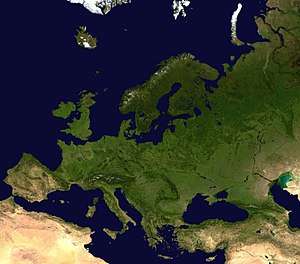Far West (Taixi)
The Far West is a Chinese and Japanese term for Europe,[1] or more broadly, to the entire Western world. Originally a name for parts of Inner Asia and India, the term Far West as a Chinese exonym for the West was coined by the Italian Jesuit priest Matteo Ricci. Ricci invented the phrase as an Asian parallel to the Eurocentric notion of the Far East, which positioned Europe as a region on the fringes of a Sinocentric world. The term Far West was also used in Japan and appears in many Japanese publications.
| Far West | |||||||
|---|---|---|---|---|---|---|---|
 A satellite image of Europe, historically referred to as the Far West in East Asia | |||||||
| Chinese name | |||||||
| Traditional Chinese | 泰西 | ||||||
| Simplified Chinese | 泰西 | ||||||
| Literal meaning | Far West | ||||||
| |||||||
| Japanese name | |||||||
| Kanji | 泰西 | ||||||
| |||||||
| Part of a series on |
| Historical Chinese exonyms |
|---|
|
History
China
It was originally used in China as a name denoting parts of Inner Asia and India. The meaning of the term was changed to encompass Europe during the Chinese Ming dynasty.[2] This semantic change is credited to the Italian Jesuit priest Matteo Ricci, who used the Far West as the Asian counterpart to the Eurocentric concept of the Far East.[2] The Jesuits called India the Little West (Chinese: 小西; pinyin: xiǎoxī) and identified their homeland as the Far West or the Great West (Chinese: 大西; pinyin: dàxī).[3]
In his essay An Essay on Friendship in Answer to Prince Jian’an, Matteo Ricci introduces himself by saying, "I, Matteo, from the Far West, have sailed across the seas and entered China with respect for learned virtue of the Son of Heaven of the Great Ming dynasty."[4] He may have used the term to ingratiate himself with his Chinese hosts by identifying Europe as a region on the western fringes of the known Sinocentric world.[5] In 1601, an editor revised the essay by replacing the term Far West with Extreme West (Chinese: 最西; pinyin: zuìxī), possibly because he considered taixi an awkward-sounding name.[2]
European knowledge was designated in China as tàixī xué (Chinese: 泰西學; lit.: 'Western learning'). Zhou Bingmo gave Western learning a more elaborate name by calling it taixi zhixue, which first appeared in a postface for the 1628 edition of Matteo Ricci's Jiren shipian (The Ten Paradoxes).[6] The term taixi was still used in the late 19th and early 20th centuries.
The "Western Sea" (Chinese: 西海; pinyin: xī hǎi) and yuanxi (Chinese: 遠西; lit.: 'Far West') were alternative Chinese names for Europe.[1] The Chinese referred to European people as xiren (Chinese: 西人; lit.: 'Western people') and European missionaries as xiru (Chinese: 西儒; lit.: 'Western scholars').[7]
The term Far West was later expanded to include the United States. The official Zhi Gang wrote a diary titled Chushi Taixi Ji (Record of the First Diplomatic Mission to the Far West) during the 1868 Burlingame Mission, a Chinese diplomatic mission to Europe and America.[8]
Japan
Europe was also called taisei ("the Far West") in Japan. Rangaku, which literally means "Dutch Learning", was an intellectual tradition that came to prominence in the Sakoku period.[9] The term taisei appears in many sources about Western learning published during that era. Examples include the Taisei gankazensho (Complete book on Western ophthalmology) in 1799, Taisei honzomeiso (Botany of the West) in 1829, and Taisei naika shusei (Compilation on Western internal medicine) in 1832.[10] Western influence also introduced the Japanese to the geographical nomenclature of Europe, which included the idea of Asia as a continent. There were some Japanese intellectuals that opposed adopting the Western notion of Asia, and instead advocated retaining East Asian geographical terminology. One example is Aizawa Seishisai (1781–1863), who claimed that calling Japan an Asian country was an insulting name for the "divine land" (神州, shinshuu). He favored the continued use of traditional terms such as "Far West" or "Southern barbarian" (南蠻, Nanban).[11]
References
Citations
- Mungello 2009, p. 8.
- Ricci 2009, p. 71.
- Brook 2009, p. 264.
- Ricci 2009, p. 87.
- Ricci 2009, p. 19.
- Brook 2009, p. 262.
- Mungello 2009, p. 9.
- Lai 1978, p. 102.
- Goodman 2000, p. 5.
- Goodman 2000, pp. 136, 163, and 161.
- Tsai 2011, p. 5.
Sources
- Brook, Timothy (2009). "Europaeology? On the Difficulty of Assembling a Knowledge of Europe in China". In M. Antoni J. Üçerler (ed.). Christianity and Cultures: Japan & China in Comparison. Institutum historicum Societatis Iesu. pp. 261–285. ISBN 978-88-7041-368-7.CS1 maint: ref=harv (link)
- Goodman, Grant K. (2000). Japan and the Dutch 1600–1853. RoutledgeCurzon. ISBN 978-1-136-83173-7.CS1 maint: ref=harv (link)
- Lai, H. Mark (1978). "The Chinese Language Sources Bibliography Project:Preliminary Findings". Amerasia Journal. UCLA Asian American Studies Center Press. 5 (2): 95–107. doi:10.17953/amer.5.2.f7v650035j8t575g.CS1 maint: ref=harv (link)
- Mungello, David E. (2009) [1999]. The Great Encounter of China and the West, 1500–1800. Rowman & Littlefield Publishers. ISBN 978-0-7425-5799-4.CS1 maint: ref=harv (link)
- Ricci, Matteo (2009). On Friendship: One Hundred Maxims for a Chinese Prince. Translated by Timothy Billings. Columbia University Press. ISBN 978-0-231-14924-2.CS1 maint: ref=harv (link)
- Tsai, Mon-Han (September 2011). ""This Culture of Ours" Politics, Confucianism, and East Asian Identities". Journal of Political Science and Sociology. Keio University (15): 1–20. ISSN 1884-9350.CS1 maint: ref=harv (link)